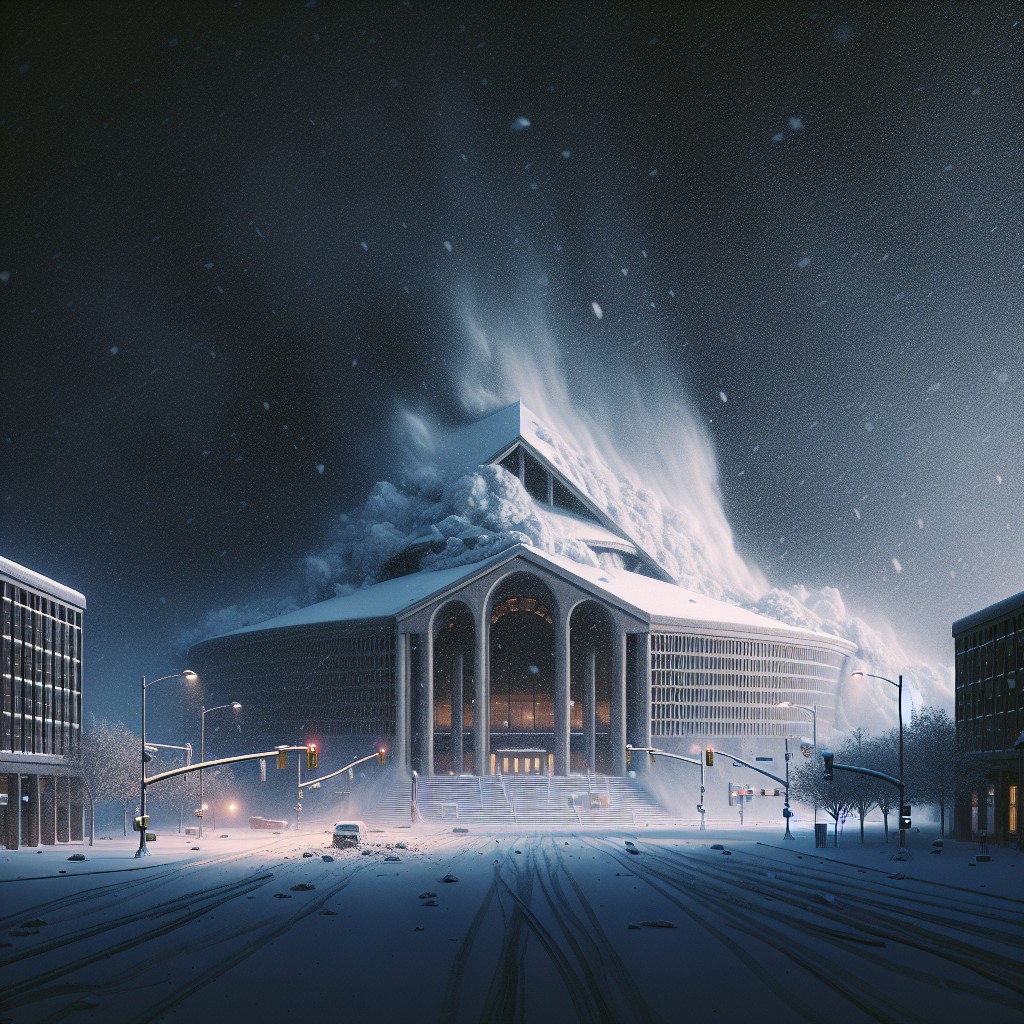Last updated on
The unexpected collapse of the Hartford Civic Center roof became a case study in structural engineering because the causes, consequences, and solutions provide invaluable insight into the complexities of roofing design and maintenance.
On January 18, 1978, the Hartford Civic Center, a landmark arena in Connecticut, became the site of a significant structural failure when its roof succumbed to the forces of nature and collapsed. This incident, occurring mere hours after a basketball game, fortunately resulted in no casualties, owing to its timing.
An investigation into the collapse disclosed critical issues with the roof’s design and construction, exacerbated by heavy snowfall and temperature variations. Subsequent material failure analysis pointed to deficiencies in both the steel used and its connections. This event not only highlighted the importance of structural integrity but also prompted a re-evaluation of engineering standards and building codes across the industry.
This article provides a comprehensive look into the causes and effects of the Hartford Civic Center roof collapse and how it reshaped the understanding of architectural safety.
Key takeaways:
- Timing of the collapse prevented loss of life
- Heavy snowfall and temperature fluctuations caused the collapse
- Design and construction flaws led to the roof’s failure
- Material failure analysis revealed steel and connection issues
- Collapse led to updates in engineering standards and building codes
Background of the Hartford Civic Center

Opening its doors in 1975, this multi-purpose facility quickly became a hub for sports, concerts, and conventions. Envisioned to spur economic development in downtown Hartford, Connecticut, the Civic Center included a stadium, exhibition hall, and a shopping concourse.
Its distinctive feature was a space-frame roof, at the time a cutting-edge design offering a wide, pillar-free space for unobstructed views. The venue served as home ice for the then-New England Whalers of the World Hockey Association, testament to its integral role in the community for both entertainment and sporting events.
Additionally, it demonstrated the era’s architectural ambition to blend functionality with innovative engineering solutions, a combination that would be put to the test in the years following its construction.
Date and Time of the Collapse

On the evening of January 18, 1978, mere hours after a basketball game with a crowd of around 5,000 people, the roof of the Hartford Civic Center caved in under the weight of heavy snow. It was approximately 4:00 a.m. when the structure failed, and by sheer luck, the arena was vacant, averting a potentially catastrophic loss of life.
This timing was pivotal, highlighting the importance of event scheduling and disaster avoidance. The night’s game and the absence of a scheduled event during the collapse played a critical role in preventing injuries. The incident underscores the necessity of vigilant maintenance, especially in regions prone to severe weather, to ensure public safety in large venues.
Weather Conditions Leading to the Collapse
On the evening of January 18, 1978, the Hartford Civic Center was hit by a fierce winter storm. This storm brought a significant snowfall, with accumulations of up to five inches across the region. The weight of the snow, coupled with the drifting caused by strong winds, placed an intense load on the roof structure.
Temperatures also played a role; after the heavy snowfall, the temperature rose and then sharply dropped, causing some of the snow to melt and then refreeze, further increasing the load on the roofing system. These factors combined to exceed the load-bearing capacity of the roof, ultimately leading to its catastrophic failure.
It is worth noting that the collapse occurred just hours after a basketball game had taken place, indicating how the timing of weather effects can be unpredictably critical.
Design and Construction of the Roof
The roof of the Hartford Civic Center, completed in 1975, showcased an ambitious engineering feat of its time. Its space frame design spanned 360 feet, free of internal pillars, offering unobstructed views to spectators.
Constructed with tubular steel members connected by high-strength bolts, the framework supported a roof clad in weathering steel, chosen for its self-protecting rust layer which obviated the need for painting.
The geometric precision inherent to the space frame structure necessitated acute attention to detail during assembly to ensure uniform load distribution.
Despite the ingenuity behind it, the catastrophic collapse later illuminated shortcomings in both the design assumptions about snow loads and the execution of its complex assembly.
Material Failure Analysis
The catastrophic event triggered an in-depth material failure analysis. Investigators focused on the physical properties of the steel used in the roof’s construction. They found that the connections between the steel members were inadequately designed to withstand the accumulated snow’s weight. Moreover, the steel itself exhibited low toughness at the frigid temperatures experienced during the collapse, which increased its susceptibility to brittle fracture.
Key points in the material failure analysis included:
- Steel Composition and Behavior: The chemical makeup and treatment of the steel were scrutinized to determine if the material met the appropriate specifications for low-temperature performance.
- Connection Design Flaws: The analysis revealed that the bolts and welds used to connect the trusses and the roof did not provide the required redundancy to distribute loads safely in the event of a local failure.
- Impact of Weather on Materials: The influence of the severe cold on the steel’s ductility, or ability to deform under stress without breaking, was a significant consideration, as materials can behave differently under extreme weather conditions.
- Load Calculations: Evaluators looked into whether the original design had adequately calculated snow loads and if proper allowances were made for unusual weather patterns.
- Inspection Protocols: It was essential to assess whether regular inspections might have detected flaws before the collapse, thereby informing maintenance and prevention strategies.
The convergence of these material and design inadequacies provided crucial insights into the disaster’s underlying causes, informing subsequent improvements in architectural practices.
Engineering Investigations and Findings
Following the collapse, extensive engineering investigations were conducted to determine the root cause. Here are the key findings from these assessments:
Understanding these findings has been fundamental in improving safety standards and preventing similar incidents in future structures.
Short-term Impacts On Events and Local Economy
The immediate aftermath of the collapse saw the cancellation and relocation of numerous scheduled events, including Hartford Whalers hockey games and various concerts, leading to direct revenue loss for event organizers and the city.
The local economy was affected as businesses, especially those in hospitality and retail that depended on event-driven traffic, experienced a downturn.
Surrounding hotels and restaurants saw a decrease in patrons.
Additionally, the construction workforce saw a temporary boost in employment opportunities during the cleanup and initial assessment phases.
However, the disaster disrupted the regular inflow of sports and entertainment enthusiasts, with a ripple effect felt by vendors, parking facilities, and public transport operators.
Long-term Safety Revisions and Building Code Changes
In response to the catastrophic event, the field of structural engineering saw an immediate call to action, resulting in more stringent building codes and safety standards. Here are some key points highlighting the changes and implications for safety and building practices:
1. Load Calculations Enhanced: Engineers began to incorporate more conservative estimates for snow and ice loads, acknowledging unpredictable weather patterns.
2. Material Testing Rigor: Materials used in construction, especially those for large span roofs, underwent more rigorous testing to prevent weaknesses that can lead to structural failures.
3. Inspection Protocols Tightened: Regular, detailed inspections became mandatory to ensure the integrity and safety of large public venues, particularly checking for any signs of material fatigue or distress.
4. Risk Management Strategies: Codes now require a comprehensive risk management strategy throughout a building’s lifecycle, extending beyond the design and construction phases.
5. Emergency Preparedness: Venues were prompted to develop emergency response plans tailored to potential structural issues, ensuring a swift and organized reaction in the event of a failure.
6. Adoption of Fail-Safe Design Features: Designs evolved to include fail-safe mechanisms that prevent total collapse, even if one part of a structure fails.
Adherence to these adjustments has made modern venues safer and has reinforced the responsibility of engineers and architects to prioritize the public’s wellbeing in their designs.
Reconstruction Efforts and Upgrades
Following the collapse, a rigorous reconstruction process was initiated to not only restore the Hartford Civic Center but also to significantly enhance its structural integrity. The following points highlight key aspects of the reconstruction and upgrades:
- Adoption of Advanced Materials: Innovative materials with higher strength-to-weight ratios were used to rebuild the roof, ensuring greater resistance to heavy snow accumulation and other environmental stressors.
- Improvement in Design: The new design incorporated state-of-the-art architectural elements to correct flaws in the original roof’s design, providing better load distribution and stability.
- Installation of Monitoring Systems: Modern sensors and monitoring equipment were installed as part of the upgrade to provide real-time data on the roof’s condition, facilitating proactive maintenance.
- Compliance with Updated Codes: The rebuilt arena adhered to more stringent building codes to mitigate the risk of future collapses and guarantee the safety of attendees and staff.
- Consultation with Structural Engineers: Expert feedback was sought throughout the reconstruction process, ensuring that the mistakes leading to the collapse were not repeated.
The overarching goal of these efforts was to revive the Civic Center as a safe, cutting-edge facility for community and sporting events, ensuring its structural resilience for years to come.
Legacy and Lessons Learned for Structural Engineering
The Hartford Civic Center collapse served as a pivotal moment in the field of structural engineering. It underscored the importance of accounting for all potential stress factors in architectural designs. Critical reflections on the disaster led to a reevaluation of how live loads, such as the weight of snow, are calculated and the necessity for robust inspection protocols post-construction.
Subsequently, engineering curricula began to place greater emphasis on failure case studies, preparing future generations of engineers with the knowledge to prevent similar catastrophes. The incorporation of redundancy into design philosophies became more prevalent, ensuring that if one component fails, the overall structure remains intact.
The incident also accelerated the adoption of computer-aided design (CAD) tools, which allow for more accurate modeling and stress analysis. Innovations in material science, driven by the analysis of the collapse, have led to the development of more resilient construction materials.
Finally, the collapse influenced regulatory updates, requiring more stringent adherence to safety standards and frequent reassessments of structural integrity over a building’s lifespan. These steps have collectively enhanced the reliability and safety of large-scale public venues around the world.
Similar Structural Failures in Other Arenas
The incident at the Hartford Civic Center was not unique in the realm of structural collapses. Several other arenas have suffered under similar circumstances, highlighting the importance of robust engineering practices.
In 1994, the roof of the Olympic Velodrome in Montreal gave way due to a build-up of snow, mirroring the weight-related issues experienced in Hartford.
The Kemper Arena in Kansas City collapsed in 1979 following a severe thunderstorm, pointing to the critical role of weather-proofing in architectural design.
The collapse of the Metrodome in Minneapolis in 2010, caused by heavy snowfall, further emphasizes the necessity for structures to accommodate regional climate conditions.
These incidents collectively underscore the need for meticulous attention to load-bearing capabilities and the effects of environmental stressors on large-scale public venues.
Effects of the Disaster On Engineering Standards
The far-reaching impact of the incident on engineering standards has led to a significant paradigm shift in building design. Intense scrutiny on past protocols precipitated the introduction of more stringent load analysis, emphasizing the need to account for cumulative effects of snow and ice.
It catalyzed a move toward redundancy in structural designs, ensuring buildings could withstand unexpected failures without catastrophic consequences. Architects and engineers now regularly incorporate fail-safes that keep structures standing if one component fails.
Advancements in materials science also emerged, with a push for better, more resilient construction materials. Roofing materials, in particular, are now subject to more rigorous testing for stress and environmental resistance.
Moreover, the incident accelerated the adoption of regular, comprehensive inspections of public venues, particularly focusing on roofs. These periodic evaluations aim to identify and mitigate potential risks, long before they pose any real threat.
Lastly, these changes have been codified into building codes and standards, which have been revised to improve safety and reduce the risk of similar disasters. Professional associations for engineers have updated their guidelines, emphasizing the importance of preparing for extraordinary environmental conditions.
Expert Panel Comments On the Collapse
Following the collapse, an expert panel formed to scrutinize the incident offered insights into the disaster’s causes. Their comments reflected a consensus that the roof’s design, while innovative, had vulnerabilities. Key points include:
– Design Vulnerability: The space frame roof, comprising welded steel and a concrete roofing system, was deemed too heavy and insufficiently supported. – Flawed Assumptions: The design didn’t fully account for the accumulative effect of wet, heavy snow on the structure, leading to incorrect estimations of load capacity. – Construction Issues: Some panel members pointed out possible shortcomings during construction, such as improper welding and connection techniques, which may have contributed to the weakness of the roof. – Maintenance Concerns: Questions were raised regarding the adequacy of maintenance checks on the roof’s integrity before the collapse.Their comments contributed to a deeper understanding of the disaster and have since informed more rigorous standards in architectural design and construction to prevent similar occurrences.
FAQ
What caused the Hartford Civic Center roof collapse?
The Hartford Civic Center roof collapsed on January 18, 1978, due to ten days of adverse weather and a snowstorm the previous night which resulted in a significant accumulation of snow and ice on the roof.
What structural failure caused the roof of the Hartford Civic Center to collapse?
The roof of the Hartford Civic Center collapsed due to gross design errors, specifically the torsional buckling of the compression members.
What happened to the Hartford Civic Center?
The Hartford Civic Center experienced a major structural failure when its roof collapsed onto 10,000 vacant seats in the early hours of January 18, 1978.
When did the Hartford Civic Center open?
The Hartford Civic Center opened on January 9, 1975.
What were the immediate impacts of the Hartford Civic Center roof collapse?
The immediate impacts of the Hartford Civic Center roof collapse included significant structural damage, event cancellations, economic loss, and a pause on public use for repairs and reconstruction.
How did the Hartford Civic Center roof collapse influence modern building codes and regulations?
The Hartford Civic Center roof collapse in 1978 considerably influenced modern building codes and regulations by emphasizing the need for more rigorous engineering assessments, safety precautions during heavy snowfall, and stringent inspection protocols for large-span structures.
Which key organizations were involved in the investigation of the Hartford Civic Center roof collapse?
The investigation of the Hartford Civic Center roof collapse engaged key organizations such as The National Bureau of Standards (now the National Institute of Standards and Technology) and the Occupational Safety and Health Administration.




